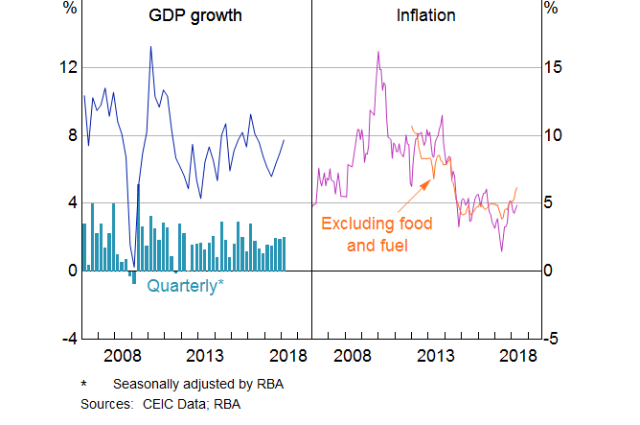
Indian economy is a dynamic and transforming economy. The United States Agency for International Development (USAID) now describes India as a "transforming" rather than a "developing" country. It indicates a new way of looking at India and the unique position she occupies in the world.
For half a century before Independence, the India Economy registered virtually no growth at all. A significant increase in the national income and the per capita income has been recorded since Independence. In the first three decades after Independence, we grew at 3.5 percent per annum. In the second three decades, the national growth went to nearly 6.0 percent. In the last four years, the growth rate was 8.5 percent per annum. The annual economic growth is the indicator that reflects the performance of any economy. Economic growth is calculated based on an increase in the Gross Domestic Product(GDP) indicating the value of goods and services produced in an economy during a year and estimated either at current or constant prices. The economy is on the rise. This has been made possible by an increasing rate of investment. In the Pre-British period, the Indian economy was self-sustained. British East India Company ruled over India from 1757 to 1858 and transformed India into a 'Classic' colony.
Commercialization of agriculture and the 'deindustrialization of India was done by the Britishers. Due to this. the Indian economy became backward. In 1905, the Swadeshi movement encouraged the growth of Indian industries. The first five-year plan described the Indian economy as an undeveloped economy. The plan was formulated to check the imbalance of the Indian economy created by the Bengal Famine of 1943 and the Partition of India in1947. The 'socialistic pattern of society' was seen as the objective of the economic policy. Indian economy evolved as a mixed economy. It is characterised by the existence of the private and public sector alongside each other. Last few years have been very good for the Indian economy. There is a considerable rise in productivity, labour and capital. If we can sustain these rates, and step up the productivity of land and labour, we should be able to attain double digit rates of growth in the near future. India is definitely on the move.

The economy witnessed fastest progress in the past 18 years. However benefits bypassed agriculture, while manufacturing and service sector saw robust growth. India's economy growth rate is second only to China among the major global economies.
C. Rangaranjan is reported to have said, ''The Indian Economy is on an unprecedented strong trajectory of economic growth". Following a growth projection of 9 percent for 2007 - 08, the figures underlined India's emergence as a global economic power. Vigorous growth in GDP, with a resurgent industrial sector and continued dynamism in services, has characterised the Indian economy of about 8.5 percent during the last four years. The data also showed the Gross Domestic Product (GDP) in the March 2007 quarter growing to 9.1 percent from a year earlier. The growth rate is clearly impressive and shows a very good performance. Analysts and officials expect the growth in Asia's third largest economy (India) to moderate at around 8 percent over the next few years.
The recent Indian growth experience is novel. India's reforms have encompassed the real, monetary, financial, fiscal and external sectors. Structural reforms have transformed the industrial sector from a command and control structure to a liberal and competitive one. The fiscal environment has been marked by prudence backed by fasical responsibility legislations, steep reductions in import duties and other tax rates, introduction of VAT, and a taxpayer friendly regime. The financial sector has been restructured with independent mechanisms in place.
India's economy has grown rapidly over the past few years based on the impressive performance of the manufacturing and the service sectors powered ahead while agriculture lagged. While the economy has grown, the benefits have largely bypassed the farming community which make uf for about 60 percent of India's total population. Growth has also been socially uneven. Hence, the challenge before us is to make the growth process more socially inclusive and regionally balanced.
While we rejoice in our success, we have to be aware of the challenges in order to maintain our impressive sojourm. We need to promote exports of goods and services in an ever so highly competitive global marketplace. This would lead to a strong edifice for sustained growth and creation of productive employment. These were the aims for which the Government of India mooted the Special Economic Zones (SEZs) policy in April 2000. This policy was intended to make the SEZs an engine for economic growth. The SEZ Act, 2005, supported by the SEZ rules, came into effect in 2006, providing for drastic simplification of procedures and for single window clearance on matters relating to central as well as state governments. The main objectives of the SEZ Act are generation of additional economic activity, promotion of exports of goods and services, promotion of investment from domestic and foreign sources, creation of employment opportunities and development of infrastructure facilities. It is hoped that the SEZs would channelise the necessary investment that the country needs for maintaining its incredible growth rate.
But we have a long way to travel for realising the full potential of our people and fulfil the promises of the father of our nation and the Architect of Modern India.
If India is looking at two decades of 10 percent growth, its policies should be long term rather than reactive. A gentler approach to currency management can be accompanied by fiscal incentives for exporters and domestic procedures which is ideally required for a balanced economic growth.
